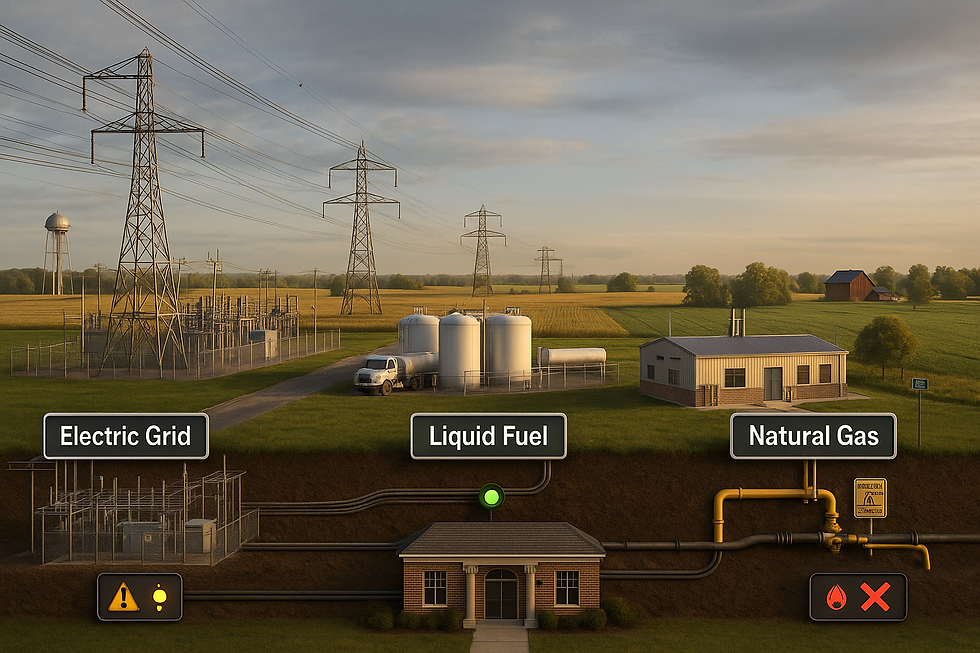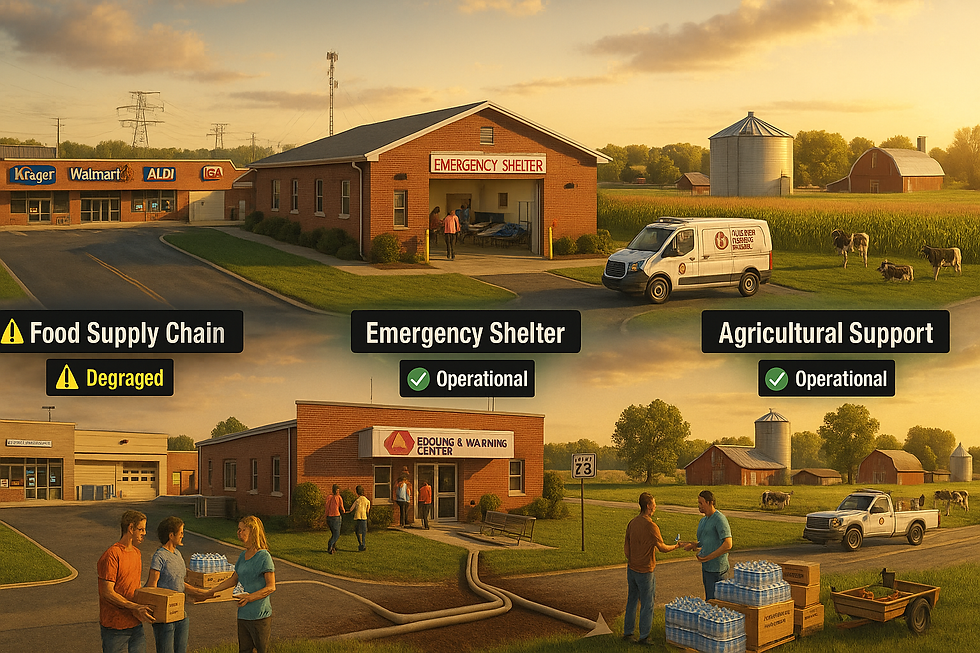Lifelines
- Thomas Breckel

- Jun 26
- 7 min read
Updated: Jun 27

Keeping Clinton County Connected: What FEMA’s Lifelines Tell Us During a Disaster
WILMINGTON, OH – When disaster hits—whether it’s a tornado, chemical spill, or power outage—emergency officials must quickly assess what’s broken and what to fix first. That decision-making starts with a framework called Community Lifelines, developed by FEMA to guide response priorities during crises.
Think of lifelines like the warning lights on your car’s dashboard. Some let you know something needs attention soon, others flash red to signal a serious failure. Either way, you know where to look—and that’s exactly how lifelines help Clinton County Emergency Management and its partners act quickly when it matters most.
Clinton County EMA uses the D4H Incident Management platform to actively track the operational status of FEMA Community Lifelines during emergencies. As conditions evolve, incident staff log disruptions, degradations, and recovery progress across each lifeline in real time. This structured tracking allows the EOC to clearly identify which systems—such as energy, water, or medical services—are most affected and to document specific problem areas within each subsector. These lifeline status entries directly inform resource requests, mission assignments, and mutual aid coordination, ensuring that efforts are focused on restoring the most critical services first. By integrating D4H with the lifeline framework, Clinton County EMA improves situational awareness, speeds up response planning, and strengthens justification for outside support from regional, state, or federal partners.
What Are FEMA’s Community Lifelines?
FEMA’s lifelines identify the seven most essential systems that support life and public safety. If any of them fail, people’s lives are at risk. Each lifeline contains several subsectors, which are tracked for their operational status. During a response, each is rated as:
Operational – Fully functioning.
Degraded ⚠️ – Partially functioning or at risk.
Non-Operational ❌ – Failing or unavailable.
This approach gives officials a shared language to identify the most urgent needs, request assistance, and communicate with the public.
1. Energy
Focus: Electricity and fuel that power homes, businesses, and critical services.

Clinton County Relevance: As of this post, Clinton County has 17,777 electric customers—each representing a household or business—served by three primary utility providers: AES Ohio, Duke Energy, and South Central Power. Power loss during severe weather or grid strain—such as during the 2023 heatwave during an outage in Blanchester—can quickly impact thousands. That event left more than 400 customers without service, including two long-term care facilities, emphasizing the importance of backup power and coordinated response.
Subsectors:
Electric Power Grid – The infrastructure that generates, transmits, and distributes electricity across the county. Outages here impact wide areas and can take time to restore depending on system damage and provider resources.
Liquid Fuel – Gasoline, diesel, and propane used for vehicles, generators, and heating. Local disruptions or delivery delays can leave responders and residents without critical fuel.
Natural Gas – Distribution systems and pipelines that provide heating and cooking energy, especially in urban areas and commercial facilities.
Status Clues:
Operational – Power is fully restored and delivery infrastructure is intact.
Degraded ⚠️ – Rolling outages, fuel delivery delays, or partial grid failure.
Non-Operational ❌ – Major grid disruption with widespread outages or loss of fuel access.
2. Water
Focus: Drinking water, sanitation, and wastewater services that prevent disease and ensure basic hygiene.

Clinton County Relevance: Boil advisories in Clarksville & Sabina have shown how even small disruptions can pose risks to rural households.
Subsectors:
Drinking Water Systems – Public and private systems for clean water.
Wastewater Systems – Sanitary sewer systems, septic, and treatment facilities.
Dams/Reservoirs – Control structures that store or manage water flow.
3. Health and Medical
Focus: Hospitals, EMS, public health systems, and access to care.

Clinton County Relevance: With only one hospital (CMH), the system could be overwhelmed during a large-scale event or mass casualty incident.
Subsectors:
Medical Care – Hospitals, clinics, and urgent care services.
EMS – Emergency transport and paramedic support.
Public Health – Disease monitoring, vaccination, outbreak response.
Patient Movement – Transport coordination to and from healthcare facilities.
4. Food, Hydration, Shelter
Focus: Access to food, safe shelter, and drinking water during disruptions.

Clinton County Relevance: Snowstorms and ice events can block supply routes and leave vulnerable residents needing shelter and basic supplies.
Subsectors:
Food Supply Chain – Grocers, warehouses, and distribution routes.
Water Distribution – Bottled and bulk water for emergency use.
Emergency Shelter – Temporary shelters for displaced residents.
Agricultural Support – Protection of livestock and crops, especially in rural areas.
5. Communications
Focus: Emergency alerts, public warning systems, and digital connectivity.

Clinton County Relevance: Downed towers or cut fiber lines have delayed 911 access in the past; amateur radio provides an essential backup.
Subsectors:
911 and Dispatch – Access to emergency call and dispatch systems.
Telecommunications – Cell towers, broadband, and landline service.
Public Alerts and Warnings – CCEA and NOAA alerting systems.
Backup Communications – Satellite phones, HAM radio, mobile repeater systems.
6. Safety and Security
Focus: Police, fire, EMS, public safety leadership, and protection of critical facilities.

Clinton County Relevance: Protests, chemical spills, or threats to schools require multi-agency response coordination.
Subsectors:
Law Enforcement – Sheriff’s Office, local police departments, mutual aid.
Fire Services – Volunteer and full-time fire departments.
Search and Rescue – Technical and wilderness SAR capabilities.
Government Operations – Continuity of leadership, EOC operations.
Community Safety – Protection of schools, government buildings, utilities.
7. Transportation
Focus: Road, rail, and air movement—especially for emergency response, supply chains, and evacuations.

Clinton County Relevance: Blocked rail crossings or bridge collapses can cut off access to entire villages or mutual aid responders.
Subsectors:
Roadways and Bridges – State, county, and township infrastructure.
Mass Transit – Limited in rural areas, but includes school buses and paratransit.
Airports and Heliports – Wilmington Air Park and medical helicopter pads.
Rail Systems – Freight movement and crossing safety via the Indiana-Ohio Railway or Greenfield Lines.
Why It Matters
This system gives local, state, and federal officials a common framework to:
Track essential services across the county.
Prioritize what to restore first.
Coordinate resource requests during emergencies.
Inform the public with actionable information.
For example, if a chemical spill near Blanchester disrupts drinking water, the Water lifeline would be marked Non-Operational, triggering alerts, mutual aid calls, and public health coordination.
What Residents Should Know
Lifelines aren’t just for emergency managers—they help the public understand which services are safe and which ones need attention. If multiple lifelines are disrupted, it’s a sign of serious system-wide failure and the need for urgent action.
What You Can Do:
Sign up for Clinton County Emergency Alerts.
Know where to shelter.
Build a household emergency kit with essentials for each lifeline. You can register to win one!
Pay attention to updates from Clinton County EMA during major events.
What about your Lifelines?
When planning for emergencies, it’s not just agencies like Clinton County EMA that

monitor Lifelines—you should too. Take a moment to apply the Lifeline concept to your own household emergency plan and kit. Which Lifelines are currently Operational for your family? Maybe you have reliable power, clean water, access to food, and the ability to communicate. But which ones might be Degraded—perhaps limited backup power, low fuel, or a lack of emergency shelter options? Are any Non-Operational, such as no alternative communications if cellular service fails? Clinton County EMA actively tracks community-wide impacts to Lifelines to guide response and resource deployment. Are you tracking the status of your own? Knowing your personal Lifeline status can guide what you should strengthen next.
Final Word
FEMA’s Community Lifelines are more than a planning tool—they’re our dashboard warning lights when something’s wrong in the community. When they blink, Clinton County EMA responds fast to steer things back on track.
When the power’s out, the sirens are silent, or the roads are blocked, lifelines help us figure out where to focus our few precious resources—because in emergencies, time is life.






Comments